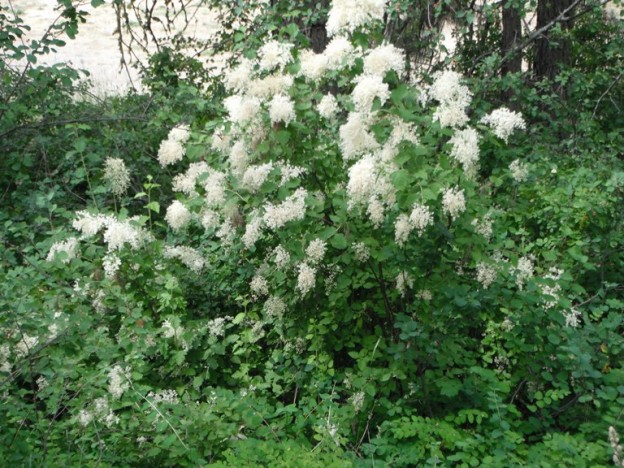Oceanspray The Rose Family–Rosaceae
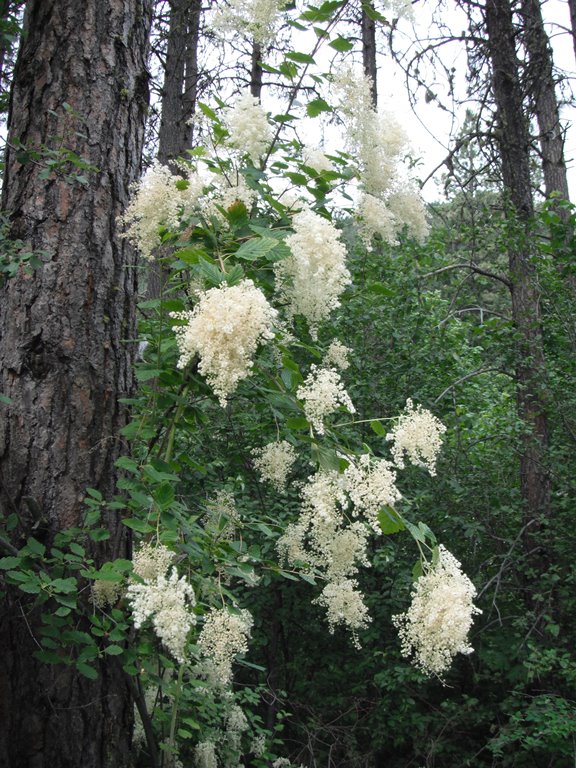 Holodiscus discolor (Pursh.) Maxim
Holodiscus discolor (Pursh.) Maxim
(hole-oh-DIS-cuss dis-KULL-er)
Names: Holodiscus means entire disc, referring to the unlobed disc lining the hypanthium (in the rose family, the hypanthium is an enlarged cup or rim that supports the sepals, petals and stamens). Discolor means two-colored; the leaves are green on the upper surface, paler beneath. It is also known as Creambush, Creambush Rock Spirea or Ironwood. Both Oceanspray and Creambush refer to its cascading, creamy-white flower clusters. It is called Ironwood due to the strength of its wood.
Relationships: There are seven to ten species of Holodiscus, all native to the Americas; from British Columbia to Bolivia. Two species are recognized by USDA in North America: Holodiscus discolor and H. dumosus, Rockspiraea, which is native from Idaho south to Arizona and western Texas. Some species, such as H. microphylla, and H. australis, recognized by other authors, are included in Holodiscus discolor.
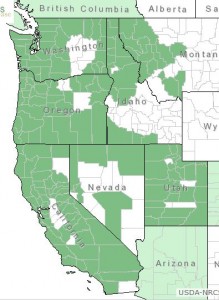
Distribution of Ocean Spray from USDA Plants Database
Distribution: It is native from southern British Columbia to southern California, east to western Montana, Colorado and Arizona. All U.S species are similar and are mostly only separated due to different leaf morphologies and distributions.
Growth: Oceanspray can range from 2.5 feet (.75m) on harsh, cold and windy sites to 12-20 feet (4- 7m) in open coastal forests, but they more often grow 3-10 feet (1-3m). They rarely live more than 30 years. Oceanspray growing near the rim of Crater Lake look very different from those growing in a sheltered forest. Besides being much shorter, the leaves are smaller and thicker.
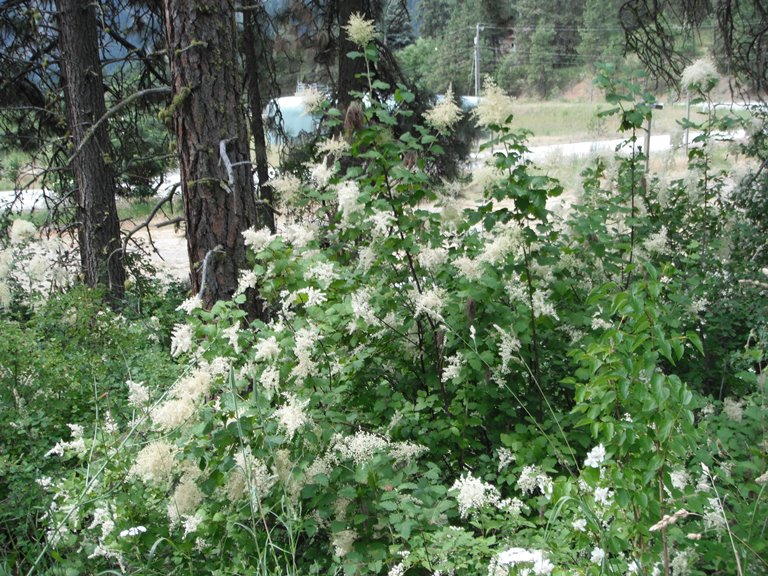
Habitat: Oceanspray grows on dry to moist, open forests or coastal bluffs and is common in open, disturbed areas, such as logged or burned areas and roadsides.
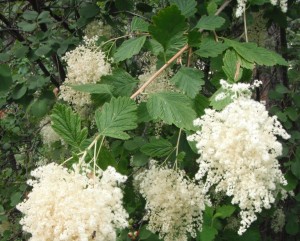 Diagnostic Characters: Oceanspray can be recognized by its alternate, oval to triangular leaves with lobed or coarsely and doubly toothed margins. The green, upper surface of the leaves can be smooth or coarsely-hairy; the paler, under surface is strongly veined and soft-hairy. Its flowers are white to cream with lilac-like drooping clusters. Seeds are actually wooly achenes (dry, one-seeded fruit) in tiny dry capsules. It usually has several main stems with brownish peeling bark; the ends of the branches arch gracefully outward.
Diagnostic Characters: Oceanspray can be recognized by its alternate, oval to triangular leaves with lobed or coarsely and doubly toothed margins. The green, upper surface of the leaves can be smooth or coarsely-hairy; the paler, under surface is strongly veined and soft-hairy. Its flowers are white to cream with lilac-like drooping clusters. Seeds are actually wooly achenes (dry, one-seeded fruit) in tiny dry capsules. It usually has several main stems with brownish peeling bark; the ends of the branches arch gracefully outward.
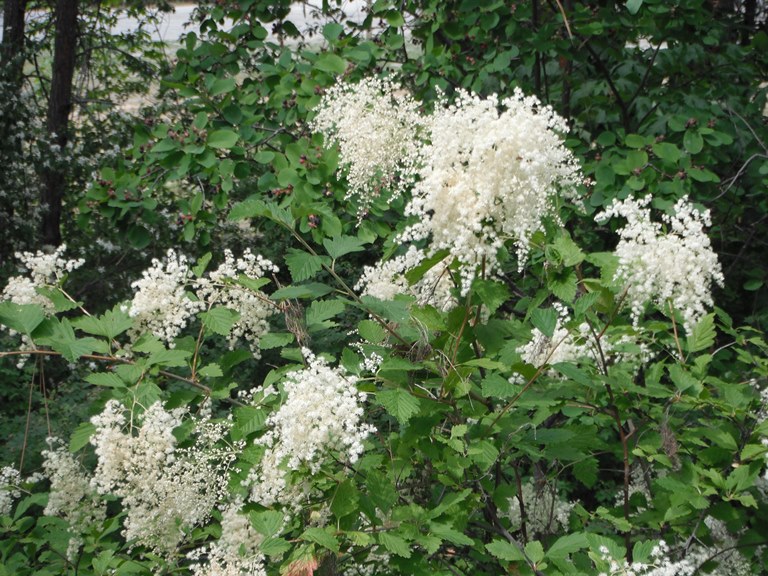
In the Landscape: Oceanspray can add charm to a garden with its attractive, small, lobed leaves and graceful arching habit. Its creamy-white drooping flower clusters are spectacular in full bloom but are not as attractive when they turn brown later in the summer. It is drought tolerant– ideal for drier areas of a landscape. It is a good choice for a sunny woodland garden, near the back of a shrub bed, or next to a building.
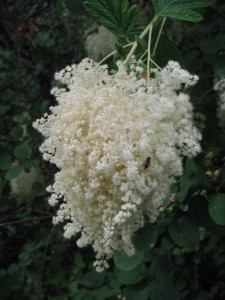 Phenology: Bloom time: June-July. Fruit ripens: Late summer.
Phenology: Bloom time: June-July. Fruit ripens: Late summer.
Propagation: Seeds require a 120 day cold stratification period at 40ºF (4ºC) but they germinate readily and abundantly after the stratification requirement is met. It is easiest just to sow the seeds in an outside bed in fall for later transplanting. Hardwood or (semi-hardwood) cuttings may have some success. Layering and division are also possible. Oceanspray will sprout from the root crown after top kill.
Use by People: The wood, known as “Ironwood” in English, was used for many tools and utensils by natives. It was made even harder by heating it over a fire and polishing it with horsetail stems. It was used for roasting tongs “because it won’t burn,” for digging sticks, fishing hooks, needles, canoe paddles, bows, and spear, harpoon, and arrow shafts, Oceanspray pegs were used in construction, when nails were not readily available.
Use by Wildlife: Oceanspray has little food value for wildlife. Browsers consume it only when more palatable food is scarce, but it appears to be palatable to native slugs. Oceanspray provides good cover for birds, small mammals and amphibians, such as the Pacific Treefrog. Flowers are pollinated by insects. Seeds, although most often disseminated by wind may also be dispersed by animals.
Links:
Consortium of Pacific Northwest Herbaria
WTU Herbarium Image Collection, Plants of Washington, Burke Museum
E-Flora BC, Electronic Atlas of the Flora of British Columbia
Jepson Eflora, University of California
Ladybird Johnson Wildflower Center
USDA Forest Service-Fire Effects Information System
Native Plants Network, Propagation Protocol Database
Native American Ethnobotany, University of Michigan, Dearborn

